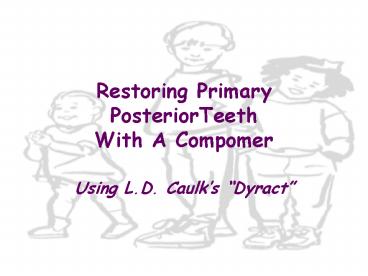Restoring Primary PosteriorTeeth With A Compomer - PowerPoint PPT Presentation
1 / 13
Title:
Restoring Primary PosteriorTeeth With A Compomer
Description:
Dyract AP (Advanced Performance) is a compomer manufactured by Caulk. Compomers are polyacid-modified hydrophilic ... Fuji II LC. Dyract. Herculite. Technique ... – PowerPoint PPT presentation
Number of Views:662
Avg rating:3.0/5.0
Title: Restoring Primary PosteriorTeeth With A Compomer
1
Restoring Primary PosteriorTeeth With A Compomer
- Using L.D. Caulks Dyract
2
Dyract AP
- Dyract AP (Advanced Performance) is a compomer
manufactured by Caulk. - Compomers are polyacid-modified hydrophilic resin
composites, containing glass particles, which are
somewhat dissolved as oral fluids activate the
acid in the biomaterial. As a result fluoride is
released, creating cariostatic potential for the
restoration.
3
Dyract AP
- Dyract is indicated for use in the conservative
restoration of primary teeth. It is not
recommended for use in permanent teeth as its
long term service characterisitics (lower
strength and higher wear rate) are less desirable
than an amalgam or a resin-based composite such
as Herculite.
4
conventional glass-ionomer
conventional resin-composite
polyacid-modified resin composite
resin-modified glass Ionomer
Ketac-Fil
Dyract
Herculite
Fuji II LC
5
Technique
- A conservative, bio-mechanically sound cavity
preparation is completed in the primary tooth. - If a Class II, the preparation should be
identical to a Class II amalgam preparation. - If a Class I, the preparation should not be
extended for prevention, rather any fissures
remaining after extending sufficiently to
eradicate the carious lesion should be
conditioned and sealed with a fissure sealant.
6
Dyract Technique
- The cavity preparation is then etched with 37
orthophosphoric acid for 20 seconds, thoroughly
washed for 20 seconds, and then air dried. - The manufacturer indicates that enamel
conditioning is not an absolute requirement when
restoring primary teeth, and the Prime and Bond
can be placed without conditioning. - However, Caulk does acknowledge that etching does
improve marginal integrity, and it is therefore
recommended by Pediatric Dentistry.
7
Dyract Technique
- Caulks Prime and Bond is placed with a clean
disposable brush, thoroughly wetting all surface
of the preparation. - The surfaces should remain wet for 20 seconds.
8
Dyract Technique
- Gently air dry for 5 seconds
- The surface should have a uniform glossy
appearance if not reapply Prime and Bond. - Light cure for 10 seconds.
- When a matrix is being utilized, Prime and Bond
should be applied and cured before the matrix
band is placed.
9
Dyract Technique
- Dyract is supplied in compules with fourteen
different shades. The shades employed with
primary teeth are the two lightest XL and B1.
10
Dyract Technique
- Dyract is dispensed in a compule and applied
using a composite gun.
11
Dyract Technique
- Apply the Dyract biomaterial in increments no
thicker than 3 mm light curing each increment
for 40 seconds. - Restore the tooth to its normal contour and
function.
12
Dyract Technique
- Finish with an appropriate composite finishing
and polishing system. - 12 fluted carbide burs can be used to finish and
contour the restoration - 7406 (egg) , for the occlusal
- 7902 (needle), for the proximal
- 7802 (bullet), for fine grooves on the occlusal
- Caulks Enhance polishing point can be used to
polish the restoration. ESPE 3Ms Softflex and
Caulks Prisma Gloss can be also used.
Alternatively, the 3300 (green) and the 3301
(gray) diacomp points can be employed.
13
Herculite
- Herculite is a conventional resin-composite. As
such, it has greater wear resistance and strength
than a polyacid-modified resin composite such as
Dyract. Therefore, it has considerable greater
longevity. - When completing Class I restorations (sometimes
referred to as Preventive Resin
Restorations-PRRs) on young permanent teeth, it
is the material of choicenot Dyract for the
reasons identified above. - Manufacturers instructions for using Herculite
should be followed. However, they are essentially
the same as those for Dyract. - Please note that the Division of Pediatric
Dentistry requires that conventional Class 1
preparations be employed in such instances,
always completed in sound dentin, and extended
such that the dentino-enamel junction of the
preparation can be visualized throughout
ensuring no caries remains at the d.e.j. This is
to be distinguished from what some advocate, that
is, that only enamel need be removed, if thought
that only enamel is involved and that a
conventional preparation with a flat pulpal floor
completed in sound dentin is not required.































